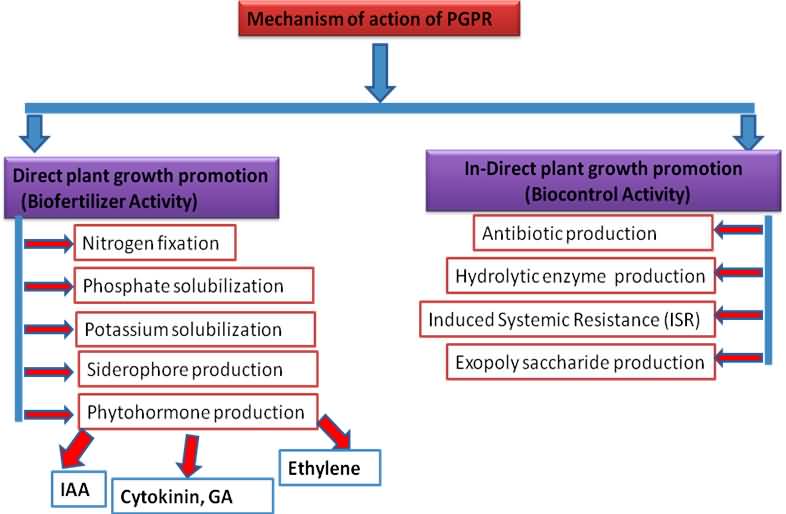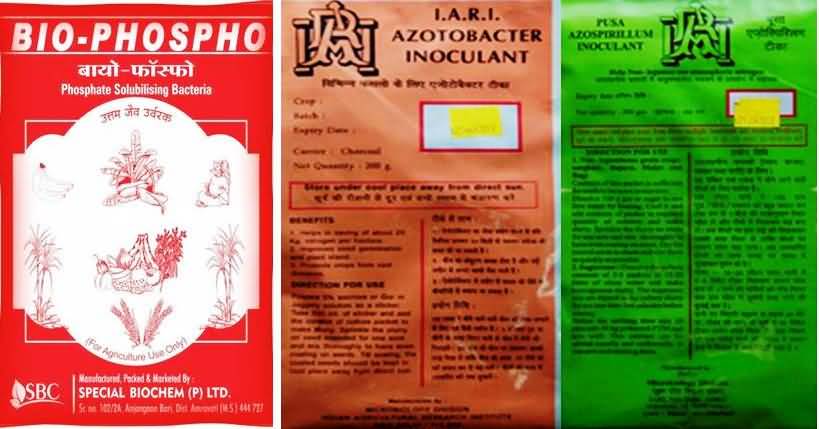अधिक फसल वृद्धि के लिए प्लांट ग्रोथ को बढ़ावा देनेे वाले राइज़ोबैक्टेरिया (पीजीपीआर) का उपयोग
Soil harbors several beneficial microorganisms and some of them colonize in the rhizospheric zone and enhance plant growth. Such bacteria are generally designated as PGPR (Plant Growth-Promoting Rhizobacteria).
Plant growth-promoting rhizobacteria (PGPR) was first defined by Kloepper and Schrot to describe soil bacteria that colonize the roots of plants following inoculation onto seed and that enhance plant growth.
Forms of Plant Growth Promoting Rhizobacterial
(पौधे का विकास बढाने वाले राईजोबैट्रीयल के रूप )
Plant growth promoting rhizobacteria can be classified into extracellular plant growth promoting rhizobacteria (ePGPR) and intracellular plant growth promoting rhizobacteria (iPGPR).
The ePGPRs may exist in the rhizosphere, on the rhizoplane or in the spaces between the cells of root cortex while iPGPRs locates generally inside the specialized nodular structures of root cells.
The bacterial genera such as Agrobacterium, Arthrobacter, Azotobacter, Azospirillum, Bacillus, Burkholderia, Caulobacter, Chromobacterium, Flavobacterium, Micrococcous, Pseudomonas and Serratia belongs to ePGPR.
The iPGPR belongs to the family of Rhizobiaceae includes Allorhizobium, Bradyrhizobium, Mesorhizobium and Rhizobium, endophytes and Frankia species both of which can symbiotically fix atmospheric nitrogen with the higher plants.
Mechanism Employed by PGPRs in Plant Growth Promotion:
(राईजोबैक्ट्रीया से पौधे के विकास की क्रियाविधि)
Plant growth promotion by plant growth promoting rhizobacteria is a well-known phenomenon and this growth enhancement is due to certain traits of rhizobacteria. There are a number of mechanisms used by PGPR for enhancing plant growth and development in diverse environmental conditions (Figure. 1).
According to one school of thought, plant growth promoting rhizobacteria mediated plant growth promotion occurs by the alteration of the whole microbial community in rhizosphere niche through the production of various substances.
Generally, plant growth promoting rhizobacteria promote plant growth directly by either supplying nutrient or by making unavailable pool to available pool of nutrients (nitrogen, phosphorus, potassium and essential minerals) or modulating plant hormone levels, or indirectly by decreasing the inhibitory effects of various pathogens on plant growth and helping in the forms of biocontrol agents, root colonizers, and environmental protectors (Figure. 1).

Figure. 1: Mode of action of Plant Growth Promoting Rhizobacteria (PGPR) for enhancing plant/crop growth (Adapted from Gupta et al., 2015)
Direct mechanisms:
1. Nitrogen fixation:
Plant growth promoting rhizobacteria have the ability to fix atmospheric nitrogen and provide it to plants by two mechanisms: symbiotic and non-symbiotic. Symbiotic nitrogen fixation is a mutualistic relationship between a microbe and the plant.
The microbe first enters the root and later on form nodules in which nitrogen fixation occurs. Rhizobia are a vast group of bacteria that have the ability to lay symbiotic interactions by the colonization and formation of root nodules with leguminous plants, where nitrogen is fixed to ammonia and make it available for the plant.
The plant growth promoting rhizobacteria widely presented as symbionts are Rhizobium, Bradyrhizobium, Sinorhizobium, and Mesorhizobium with leguminous plants, Frankia with non-leguminous trees and shrubs.
On the other hand, non-symbiotic nitrogen fixation is carried out by free living diazotrophs and this can stimulate non-legume plants growth such as radish and rice. Non-symbiotic Nitrogen fixing rhizospheric bacteria belonging to genera including Azoarcus, Azotobacter, Acetobacter, Azospirillum, Burkholderia, Diazotrophicus, Enterobacter, Gluconacetobacter, Pseudomonas and cyanobacteria (Anabaena, Nostoc).
2. Phosphate solubilization:
Phosphorus is abundantly available in soils in both organic and inorganic forms. Plants are unable to utilized phosphate because 95-99% phosphate present in the insoluble, immobilized, and precipitated form. Plants absorb phosphate only in two soluble forms, the monobasic (H2 PO4) and the dibasic (HPO4 2-) ions.
Plant growth promoting rhizobacteria present in the soil employ different strategies to make use of unavailable forms of phosphorus and in turn also help in making phosphorus available for plants to absorb. The main phosphate solubilization mechanisms employed by plant growth promoting rhizobacteria include:
- release of mineral dissolving compounds e.g. organic acid anions, protons, hydroxyl ions, CO2 ,
- liberation of extracellular enzymes (biochemical phosphate mineralization) and
- the release of phosphate during substrate degradation (biological phosphate mineralization).
Phosphate solubilizing PGPR included in the genera Arthrobacter, Bacillus, Beijerinckia, Burkholderia, Enterobacter, Erwinia, Flavobacterium, Microbacterium Pseudomonas, Rhizobium, Rhodococcus, and Serratia have attracted the attention of agriculturists as soil inoculums to improve plant growth and yield.
3. Potassium solubilization:
Potassium (K) is the third major essential macronutrient for plant growth. The concentrations of soluble potassium in the soil are usually very low and more than 90% of potassium in the soil exists in the form of insoluble rocks and silicate minerals. Without adequate potassium, the plants will have poorly developed roots, grow slowly, produce small seeds and have lower yields.
Plant growth promoting rhizobacteria are able to solubilize potassium rock through production and secretion of organic acids. Potassium solubilizing plant growth promoting rhizobacteria such as Acidothiobacillus ferrooxidans, Bacillus edaphicus, Bacillus mucilaginosus, Burkholderia, Paenibacillus sp. and Pseudomonas has been reported to release potassium in accessible form from potassium bearing minerals in soils.
Thus, application of potassium solubilizing plant growth promoting rhizobacteria as biofertilizer for agriculture improvement can reduce the use of agrochemicals and support ecofriendly crop production.
4. Siderophore production:
Iron is an essential micronutrient for almost all organisms in the biosphere. Despite the fact that iron is the fourth most abundant element on earth, in aerobic soils, iron is not readily assimilated by either bacteria or plants because ferric ion or Fe+3, which is the predominant form in nature, is only sparingly soluble so that the amount of iron available for assimilation by living organisms is extremely low.
Microorganisms have evolved specialized mechanisms for the assimilation of iron, including the production of low molecular weight iron-chelating compounds known as siderophores, which transport this element into their cell. Examples of some beneficial microbes under this group is Azotobacter, Bacillus, Burkholderia, Pseudomonas, Rhizobium, Serratia and Streptomyces sp.
5. Phytohormone production:
A wide range of microorganisms found in the rhizosphere are able to produce substances that regulate plant growth and development. Plant growth promoting rhizobacteria produce phytohormones such as auxins, cytokinins, gibberellins and Ethylene can affect cell proliferation in the root architecture by overproduction of lateral roots and root hairs with a subsequent increase of nutrient and water uptake.
Several plant growth promoting rhizobacteria Azotobacter sp., Rhizobium sp., Pantoea agglomerans, Rhodospirillum rubrum, Pseudomonas fluorescens, Bacillus subtilis and Paenibacillus polymyxa can produce cytokinins or gibberellins or both can produce either cytokinins or gibberellins or both for plant growth promotion.
Currently, bacterial strains exhibiting ACC deaminase activity have been identified in a wide range of genera such as Acinetobacter, Achromobacter, Agrobacterium, Alcaligenes, Azospirillum, Bacillus, Burkholderia, Enterobacter, Pseudomonas, Ralstonia, Serratia and Rhizobium etc.
In-direct mechanisms:
Plant growth promoting rhizobacteria is a promising sustainable and environmentally friendly approach to control phytopathogens and thus help in soil and plant growth indirectly.
1. Antibiosis:
The production of antibiotics is considered to be one of the most powerful and studied biocontrol mechanisms of plant growth promoting rhizobacteria against phytopathogens has become increasingly better understood over the past two decades.
A variety of antibiotics have been identified, including compounds such as amphisin, 2,4-diacetylphloroglucinol (DAPG), oomycin A, phenazine, pyoluteorin, pyrrolnitrin, tensin, tropolone, and cyclic lipopeptides produced by pseudomonads and oligomycin A, kanosamine, zwittermicin A, and xanthobaccin produced by Bacillus, Streptomyces, and Stenotrophomonas sp. to prevent the proliferation of plant pathogens (mainly fungi).
2. Lytic enzymes:
Growth enhancement through enzymatic activity is another mechanism used by plant growth promoting rhizobacteria. Plant growth promoting rhizobacterial strains can produce certain enzymes such as chitinases, dehydrogenase, β-glucanase, lipases, phosphatases, proteases etc. exhibit hyperparasitic activity, attacking pathogens by excreting cell wall hydrolases.
3. Induced systemic resistance (ISR):
Induced resistance may be defined as a physiological state of enhanced defensive capacity elicited in response to specific environmental stimuli and consequently the plant’s innate defenses are potentiated against subsequent biotic challenges.
Biopriming plants with some plant growth promoting rhizobacteria can also provide systemic resistance against a broad spectrum of plant pathogens. Diseases of fungal, bacterial, and viral origin and in some instances even damage caused by insects and nematodes can be reduced after application of plant growth promoting rhizobacteria.
Moreover, induced systemic resistance involves jasmonate and ethylene signaling within the plant and these hormones stimulate the host plant’s defense responses against a variety of plant pathogens.
4. Exo polysaccharides production or biofilm formation:
Certain bacteria synthesize a wide spectrum of multifunctional polysaccharides including intracellular polysaccharides, structural polysaccharides, and extracellular polysaccharides. Production of exo polysaccharides is generally important in biofilm formation; root colonization can affect the interaction of microbes with roots appendages.
Effective colonization of plant roots by EPS-producing microbes helps to hold the free phosphorous from the insoluble one in soils and circulating essential nutrient to the plant for proper growth and development and protecting it from the attack of foreign pathogens.
Other innumerable functions performed by EPS producing microbes constitute shielding from desiccation, protection against stress, attachment to surfaces plant invasion, and plant defense response in plant–microbe interactions.
Commercialization of PGPR:
The success and commercialization of plant growth promoting rhizobacterial strains depend on the linkages between the scientific organizations and industries. Moreover, commercial success of PGPR strains requires economical and viable market demand, consistent and broad spectrum action, safety and stability, longer shelf life, low capital costs and easy availability of career materials.
Plant Growth Promotory Bioformulations
Bioformulations are best defined as biologically active products containing one or more beneficial microbial strains along with carrier material. Most bioformulations are meant for field application, it is essential that suitable carrier materials are used to maintain cell viability under adverse environmental conditions.
A good quality formulation promotes survival of bacteria maintaining available population that are sufficient to exude growth promoting effects on plants. Plant growth promoting rhizobacterial bioformulation refers to preparations of microorganism that may be partial or complete substitute for chemical fertilization, pesticides, offer an environmentally sustainable approach to increase crop production and health.
Examples of some commercialized PGPR products:
Several PGPR formulations are commercially available in market by different commercial producer and different Govt institution. As for example formulation of Azotobacter, Compost inoculants, Phosphorus solubilizing bacteria (Bio-phospho), VAM inoculants etc.
Nitrogen fixing inoculants and Phosphorus solubilizers
Reference:
Gupta G, Singh Parihar S, Kumar Ahirwar N, Snehi S and Singh V (2015) Plant Growth Promoting Rhizobacteria (PGPR): Current and Future Prospects for Development of Sustainable Agriculture. Microbial & Biochemical Technology. 7(2): 096-102.
Authors
Namita Das Saha1, P Saha2, B Gurung3 and A Bhowmick3
1Centre for Environment Science and Climate Resilient Agriculture (CESCRA),
2Division of Vegetable Science,
Indian Agricultural Research Institute (IARI), Pusa, New Delhi-110012,
3Indian Agricultural Statistics Research Institute (IASRI), Pusa, New Delhi-110012
Email:

